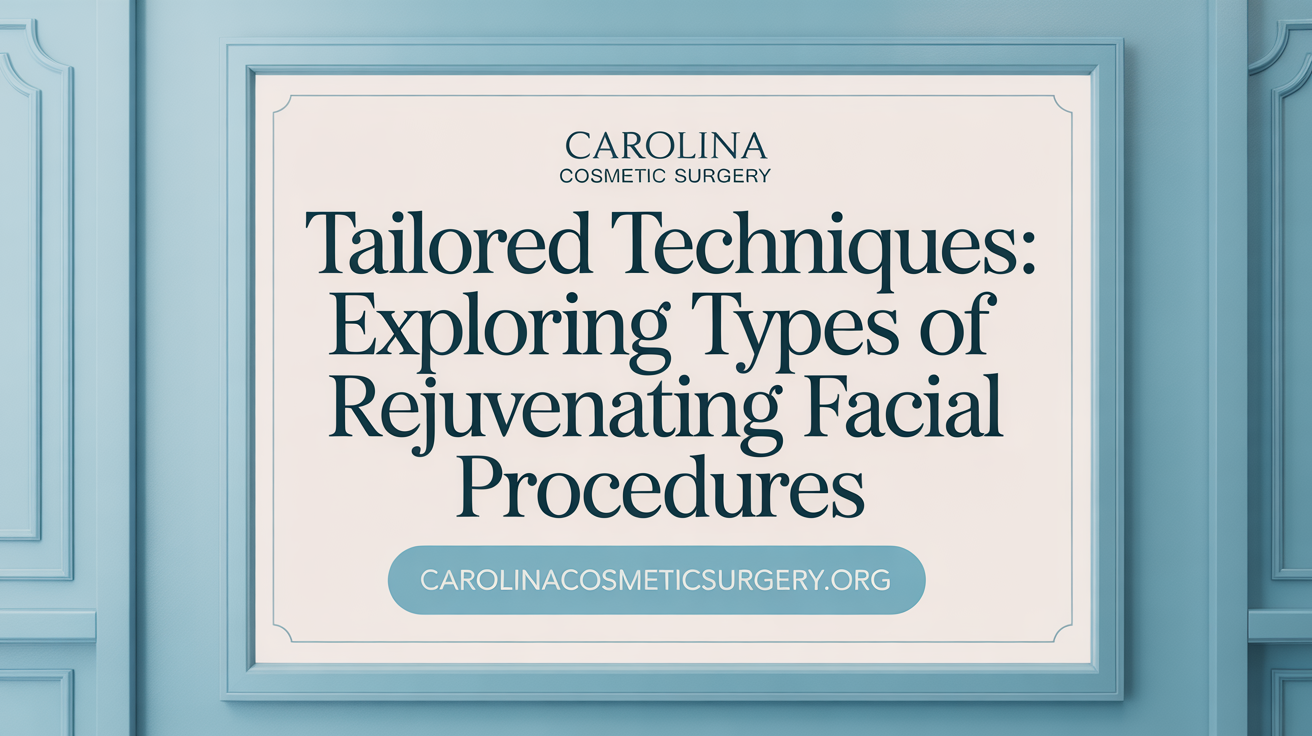Understanding the Future of Facelifts
The field of cosmetic surgery continues to evolve, offering patients advanced methods for natural-looking facial rejuvenation with minimal downtime. Among these innovations, endoscopic facelift techniques have emerged as a leading choice for individuals seeking subtle, effective correction of early to moderate signs of aging. By harnessing the power of minimally invasive technology, endoscopic facelifts provide targeted lifting and tissue repositioning with reduced scarring and quicker recovery. This article delves deep into what endoscopic facelift procedures entail, their benefits, techniques, candidate suitability, surgical details, and supporting scientific evidence, offering a comprehensive guide for those considering this modern approach to facial rejuvenation.
Defining Endoscopic Facelift Techniques: A Minimally Invasive Approach

What are endoscopic facelift techniques?
Endoscopic facelift techniques are innovative, minimally invasive facial rejuvenation procedures that utilize a small camera, known as an endoscope, along with specialized instruments inserted through tiny incisions. These incisions are typically discreetly placed in areas such as behind the hairline or inside the mouth, resulting in minimal visible scarring. Using the endoscope, surgeons can see and access deeper tissues, muscles, and fat layers of the face, allowing precise lifting and repositioning without the extensive tissue removal associated with traditional facelifts.
This approach focuses on tightening the underlying support structures of the face—especially the SMAS layer—rather than merely lifting the skin. It is particularly suited for patients showing early to moderate signs of aging, such as sagging cheeks, mild jowling, and brow laxity.
Why choose a minimally invasive technique?
Compared to traditional facelift surgeries, endoscopic methods significantly reduce the trauma to facial tissues. Patients benefit from smaller incisions, less postoperative swelling and bruising, shorter recovery times, and more natural-looking results. The precision afforded by the endoscope also improves the surgeon’s ability to target specific areas, leading to a more refined and subtle enhancement.
Which areas are targeted?
Endoscopic facelifting is especially effective for the midface, including the cheeks, as well as the brow and forehead area. It can lift and tighten sagging tissues, correct early jowling and improve overall facial contours. The procedure is designed to restore youthful firmness and facial symmetry with minimal disruption to the surrounding tissues.
How does it compare to traditional facelift procedures?
Traditional facelifts involve larger incisions, often around the ears and extending into the hairline, with more extensive skin and tissue removal. They typically require longer operative and recovery times, and carry a higher risk of visible scarring. In contrast, endoscopic facelifts involve smaller incisions, less tissue dissection, and a faster return to normal activities.
This less invasive nature makes endoscopic techniques suitable for patients with early signs of aging, those who prefer a less noticeable recovery process, or individuals seeking maintenance procedures for youthful facial features.
Ideal candidates for endoscopic facelifts
People in their late 30s to early 50s with mild to moderate facial sagging often find these procedures most beneficial. Good candidates are generally healthy, have realistic expectations, and desire subtle, natural-looking rejuvenation without significant downtime. It is important to consult with an experienced, board-certified plastic surgeon to determine if this technique aligns with individual aesthetic goals and facial anatomy.
By focusing on precision and minimal invasiveness, endoscopic facelift procedures continue to grow in popularity among those seeking a youthful appearance with fewer risks and a quicker recovery.
Step-by-Step: How Endoscopic Facelift Procedures Are Performed
How are endoscopic facelift procedures performed?
An endoscopic facelift begins with the administration of anesthesia, usually general or IV sedation, to ensure patient comfort. The surgeon makes several tiny incisions, typically hidden within the hairline or behind the ears, to access the underlying facial tissues.
A small, thin instrument called an endoscope, equipped with a light and camera, is inserted through these incisions. The endoscope provides real-time visualization of deep tissues, muscles, and ligaments, allowing the surgeon to operate with high precision.
Using specialized surgical instruments inserted alongside the endoscope, the surgeon lifts, repositions, and tightens the tissues and muscles affected by aging, especially in the mid-face and jawline regions. This targeted approach helps restore a more youthful contour while minimizing trauma to surrounding tissues.
Once the tissues are properly positioned and secured, the surgeon closes the small incisions with fine sutures. The tiny size of the incisions ensures minimal scarring. The procedure typically takes about two to three hours, depending on the extent of rejuvenation needed.
The entire process emphasizes precision and minimal invasion, resulting in less swelling, reduced discomfort, and a faster recovery compared to traditional facelift techniques. Patients can usually return to normal activities within two weeks, with natural-looking results that last several years.
Advantages of Endoscopic Facelifts over Traditional Methods

What are the benefits and advantages of endoscopic facelift methods compared to traditional facelifts?
Endoscopic facelift techniques offer numerous advantages in facial rejuvenation, especially for individuals seeking less invasive options with quicker recovery times. One of the most notable benefits is minimal scarring. Unlike traditional facelifts, which involve longer incisions often visible around the ears and neck, endoscopic procedures use tiny incisions typically hidden within the hairline or inside the mouth. This results in less noticeable scars and a more natural appearance.
Another major benefit is reduced swelling and bruising post-surgery. Because endoscopic methods involve less tissue dissection and manipulation, patients experience a milder, more comfortable recovery. This generally allows most individuals to resume normal activities within one to two weeks, compared to the longer, often more uncomfortable, recovery associated with traditional facelifts.
Endoscopic facelifts focus primarily on the midface, cheeks, and brow areas, making them ideal for early to moderate signs of aging such as mild sagging, loss of cheek volume, and early jowling. They are designed to lift and reposition tissues with targeted precision, avoiding extensive tissue disruption. This focus leads to natural-looking results that enhance facial contours without the stretched or overly tight appearance sometimes associated with more invasive surgery.
In addition, these techniques typically require less anesthesia and cause less discomfort during and after the procedure. The use of small cameras and specialized instruments allows surgeons to carefully access hard-to-reach areas like the brow and upper cheeks, providing a vertical lift that restores youthful facial proportions.
Compared to traditional methods, endoscopic facelifts involve smaller, less invasive incisions, reducing the risk of complications such as nerve injury, scarring, and prolonged swelling. They are especially suitable for patients in the early stages of aging who desire subtle, natural results with minimal downtime.
In summary, endoscopic facelift techniques combine effectiveness with gentler procedures, making them a popular choice for candidates who want targeted facial rejuvenation with a quicker recovery and less visible signs of surgery.
Who Should Consider an Endoscopic Facelift? Candidate Suitability and Considerations
Who is a suitable candidate for an endoscopic facelift?
Endoscopic facelifts are best suited for individuals facing early signs of facial aging, especially those with mild to moderate sagging and wrinkles in the midface, cheeks, and brow area. Typically, candidates are in their 40s to early 50s, seeking natural-looking results with minimal scars and a faster recovery.
A key requirement is good skin elasticity, which allows the skin to tighten and adapt after the procedure. Strong, well-defined facial bones help achieve better and more natural results as they support the lifted tissues.
Candidates should be in good overall health, non-smokers, and free from significant medical issues that could impair healing or increase risks during surgery. Maintaining a healthy lifestyle and managing underlying health conditions contribute to optimal outcomes.
It's also important for candidates to have realistic expectations about what an endoscopic facelift can achieve. The procedure primarily targets early to moderate signs of aging and offers subtle, natural improvements rather than dramatic changes.
Why are these factors important?
The effectiveness of an endoscopic facelift relies heavily on the patient’s skin condition and facial structure. Elastic skin responds well to the lifting, while aging factors like skin looseness and bone resorption influence how long the results last.
The minimally invasive approach is ideal for those who want a less traumatic alternative to traditional surgery. However, it might not be suitable for severe sagging or extensive facial aging, which could require more invasive procedures.
What are the limitations and indications for candidacy?
This technique is most effective for early-stage signs of aging. Patients with significant skin laxity, severe jowling, or advanced sagging might not see the desired results from an endoscopic approach alone.
Additionally, individuals with significant skin thickness, previous facial surgeries, or certain medical conditions should consult their surgeon to determine appropriate options.
In summary, candidates should be healthy individuals with mild to moderate facial aging signs, good skin and bone support, and a desire for natural results with minimal downtime.
Anatomy and Surgical Details in Endoscopic Facelift Techniques
What are the surgical anatomy and procedural details involved in endoscopic facelifts?
Endoscopic facelifts are carefully planned procedures that require precise knowledge of facial anatomy and skillful surgical techniques. The process begins with small incisions typically placed within the hairline or behind the ears, which serve to minimize visible scarring.
The surgeon inserts an endoscope— a long, thin tube equipped with a light and camera—through these tiny incisions. This device provides magnified visualization of the facial structures, allowing for accurate and safe manipulation of tissues.
A major aspect of the technique involves the dissection of specific tissue layers, particularly the superficial musculoaponeurotic system (SMAS). The surgeon uses specialized instruments to elevate and reposition this layer along with the facial muscles, including the malar fat pad and platysma, to correct sagging and deepen the youthful contours.
Hydrodissection is often used to facilitate the separation of tissue planes. By injecting a solution to loosen tissues, the surgeon can achieve a clean and controlled dissection, reducing trauma and swelling.
Targeted tissue layers include not only the SMAS but also underlying muscles and fat pads. Elevating the malar fat pad restores volume to the cheeks, while repositioning muscles around the jawline helps define the lower face.
Safety measures are paramount, especially concerning facial nerves. The surgeon carefully preserves nerve integrity by understanding their pathways and avoiding excessive dissection near nerve branches. This vigilance helps prevent complications such as sensory loss or muscle weakness.
At the conclusion of the procedure, sutures are used to secure tissue repositioning, and small incisions are closed with fine sutures or skin adhesives. This meticulous approach aims to produce natural results with minimal visible scars.
Overall, endoscopic facelifts leverage detailed anatomical knowledge and advanced visualization techniques. This enables targeted tissue manipulation, delivering effective rejuvenation with less trauma, quicker recovery, and more natural facial expressions.
Exploring Different Endoscopic Facelift Techniques: Characteristics and Applications

What are the different types of endoscopic facelift techniques and their specific characteristics?
Endoscopic facelifts encompass several specialized techniques designed to rejuvenate the face with minimal invasiveness. Two prominent procedures are the endoscopic midface lift and the endoscopic brow and forehead lift.
The endoscopic midface lift primarily targets lifting and repositioning the middle part of the face. Using small incisions concealed within the hairline, surgeons access underlying tissues and muscles to elevate sagging cheeks and reduce deep nasolabial folds. This technique involves endoscopic dissection beneath the skin to achieve a more youthful, vertical lift, restoring facial volume and support.
Conversely, the endoscopic brow and forehead lift focuses on elevating and smoothing the forehead and brow area. It addresses issues such as forehead wrinkles, drooping eyebrows, and hooded eyelids. Similar to the midface lift, this procedure employs small, discreet incisions and an endoscope for precise visualization and manipulation of tissues.
Both methods utilize a tiny camera to guide the surgeon during surgery, allowing for meticulous dissection and repositioning of deeper facial structures. These approaches deliver natural-looking results and tend to last longer because they lift tissues from within rather than just skin removal.
The choice between these techniques depends on the patient's specific aging signs, with both offering benefits such as:
- Minimal scarring
- Quicker recovery times
- Reduced discomfort post-surgery
- Preservation of natural facial expressions
Overall, these tailored endoscopic procedures provide effective facial rejuvenation with less downtime compared to traditional open surgeries, making them ideal for individuals with mild to moderate aging signs seeking subtle, enduring improvements.
The Recovery Journey: Postoperative Care and Expectations

What does the recovery process look like after an endoscopic facelift?
The recovery journey after an endoscopic facelift generally involves a calm period of mild swelling, bruising, and some discomfort. These effects can last from a few days up to a week, depending on individual healing responses.
Patients are advised to rest adequately and avoid strenuous activities, such as heavy lifting or intense exercise, for at least two weeks. During this time, it’s common to experience some numbness, tightness, or a sensation of minimal tension in the treated facial areas.
Most individuals can expect to resume their normal routines, including returning to work, within about 7 to 10 days. The exact timing depends on personal healing speed and the nature of one’s daily activities. Light social engagements and normal errands are typically permissible after this initial period.
Follow-up visits with the surgeon are crucial during the recovery period. These appointments allow the surgeon to monitor healing progress, remove sutures if necessary, and address any emerging concerns such as unusual swelling or discomfort.
Proper postoperative care—such as keeping the head elevated, applying cold compresses, taking prescribed medications, and following surgeon instructions—helps ensure optimal healing and reduces the risk of complications.
Understanding these expectations can help patients plan their recovery effectively, minimizing stress and promoting natural, long-lasting results.
Scientific Evidence Supporting Endoscopic Facelift Procedures

What scientific research supports the effectiveness of endoscopic facelift procedures?
Numerous scientific studies affirm the safety and efficacy of endoscopic facelift techniques. Notably, research involving a retrospective analysis of 140 patients aged between 33 and 67 years demonstrated that these procedures significantly improve facial aesthetics, with an average rejuvenation effect estimated at around 18 years. The studies highlight that the vertical lifting of the superficial musculoaponeurotic system (SMAS) and the use of endoscopic dissection planes, such as subgaleal and subperiosteal, contribute to natural, long-lasting results.
In a detailed technical review, 47 patients underwent endoscopic midface lifts, showing impressive outcomes with minimal complications. The use of photographic analyses confirmed a mean reduction of 22.45% in lower eyelid length after surgery, indicating effective periorbital rejuvenation. Patient satisfaction rates in these studies exceeded 93%, with most individuals reporting high confidence in their results and minimal postoperative discomfort.
Furthermore, research consistently demonstrates that endoscopic procedures offer reduced complication rates, such as minimal scarring, less swelling, and faster recovery times. These benefits are attributed to smaller incisions and targeted tissue manipulation, preserving facial nerve function and minimizing tissue trauma.
Objectively, statistically significant improvements were reported through photographic comparisons and clinical evaluations, confirming the procedures' aesthetic advancements and stability over time. Data indicate that results usually last between 5 and 8 years, with some cases enduring up to a decade with proper maintenance.
In summary, current scientific evidence supports endoscopic facelift methods as safe, effective, and durable options for facial rejuvenation, especially for patients seeking minimally invasive techniques with natural-looking results. These studies highlight their advantages over traditional approaches while maintaining a focus on patient safety and satisfaction.
Search query for further research: research on endoscopic facelift efficacy
Endoscopic Facelifts: A Modern Solution for Natural Facial Rejuvenation
Endoscopic facelift techniques represent a significant advancement in cosmetic facial surgery, combining minimally invasive methods with precise anatomical targeting to rejuvenate the face with less trauma and quicker recovery. Ideal for patients experiencing mild to moderate signs of aging, these procedures offer natural-looking, long-lasting results, particularly in the midface and brow regions. The variety of techniques available allows surgeons to tailor treatments to individual needs, ensuring subtle enhancements that preserve facial expression and integrity. Supported by robust scientific research demonstrating safety and efficacy, the endoscopic facelift stands as a proven option for those seeking effective facial rejuvenation with fewer risks and reduced downtime. As surgical expertise and technology continue to evolve, endoscopic facelifts will likely become an increasingly favored approach, heralding a new era in aesthetic medicine.
References
- Endoscopic Facelift Procedure, Cost, Before & After, Reviews
- Endoscopic Facelift in Houston | Henry A. Mentz
- What Are The Benefits Of An Endoscopic Facelift - Optimization Centre
- Transtemporal Endoscopic Deep Plane Face Lift - PMC
- Endoscopic Facelift London - Waterhouse & Janssen
- Facelift Techniques: The Ultimate Guide - Konstantin Vasyukevich, MD
- Endoscopic assisted facial rejuvenation: a 35 year personal journey
- Facelifting Techniques - EyeWiki
- Endoscopic Facelift- What Is It, Symptoms And Treatment
